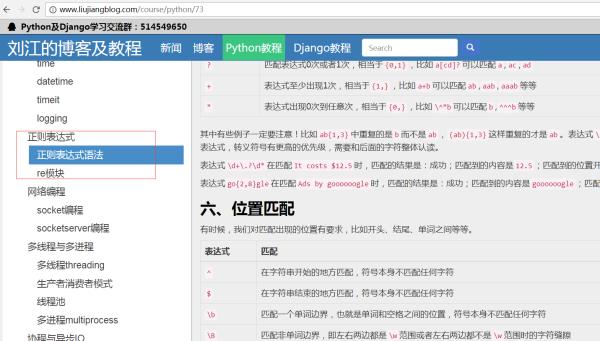python 正则表达式怎么匹配
Posted
tags:
篇首语:本文由小常识网(cha138.com)小编为大家整理,主要介绍了python 正则表达式怎么匹配相关的知识,希望对你有一定的参考价值。
Python本不等于正则语言,它只是内部集成了一个正则引擎,这个引擎实现了正则语言的功能,在Python中,这个引擎就是re模块。所以,你要先‘import re’。
下面网页详细介绍了正则本身和re模块,可供参考,基本上覆盖了所有内容。

1. 正则表达式基础
1.1. 简单介绍
正则表达式并不是Python的一部分。正则表达式是用于处理字符串的强大工具,拥有自己独特的语法以及一个独立的处理引擎,效率上可能不如str自带的方法,但功能十分强大。得益于这一点,在提供了正则表达式的语言里,正则表达式的语法都是一样的,区别只在于不同的编程语言实现支持的语法数量不同;但不用担心,不被支持的语法通常是不常用的部分。如果已经在其他语言里使用过正则表达式,只需要简单看一看就可以上手了。
下图展示了使用正则表达式进行匹配的流程: 
正则表达式的大致匹配过程是:依次拿出表达式和文本中的字符比较,如果每一个字符都能匹配,则匹配成功;一旦有匹配不成功的字符则匹配失败。如果表达式中有量词或边界,这个过程会稍微有一些不同,但也是很好理解的,看下图中的示例以及自己多使用几次就能明白。
下图列出了Python支持的正则表达式元字符和语法: 
1.2. 数量词的贪婪模式与非贪婪模式
正则表达式通常用于在文本中查找匹配的字符串。Python里数量词默认是贪婪的(在少数语言里也可能是默认非贪婪),总是尝试匹配尽可能多的字符;非贪婪的则相反,总是尝试匹配尽可能少的字符。例如:正则表达式"ab*"如果用于查找"abbbc",将找到"abbb"。而如果使用非贪婪的数量词"ab*?",将找到"a"。
1.3. 反斜杠的困扰
与大多数编程语言相同,正则表达式里使用"\\"作为转义字符,这就可能造成反斜杠困扰。假如你需要匹配文本中的字符"\\",那么使用编程语言表示的正则表达式里将需要4个反斜杠"\\\\\\\\":前两个和后两个分别用于在编程语言里转义成反斜杠,转换成两个反斜杠后再在正则表达式里转义成一个反斜杠。Python里的原生字符串很好地解决了这个问题,这个例子中的正则表达式可以使用r"\\\\"表示。同样,匹配一个数字的"\\\\d"可以写成r"\\d"。有了原生字符串,你再也不用担心是不是漏写了反斜杠,写出来的表达式也更直观。
1.4. 匹配模式
正则表达式提供了一些可用的匹配模式,比如忽略大小写、多行匹配等,这部分内容将在Pattern类的工厂方法re.compile(pattern[, flags])中一起介绍。
2. re模块
2.1. 开始使用re
Python通过re模块提供对正则表达式的支持。使用re的一般步骤是先将正则表达式的字符串形式编译为Pattern实例,然后使用Pattern实例处理文本并获得匹配结果(一个Match实例),最后使用Match实例获得信息,进行其他的操作。
123456789101112131415# encoding: UTF-8import re # 将正则表达式编译成Pattern对象pattern = re.compile(r'hello') # 使用Pattern匹配文本,获得匹配结果,无法匹配时将返回Nonematch = pattern.match('hello world!') if match: # 使用Match获得分组信息 print match.group() ### 输出 #### hellore.compile(strPattern[, flag]):
这个方法是Pattern类的工厂方法,用于将字符串形式的正则表达式编译为Pattern对象。 第二个参数flag是匹配模式,取值可以使用按位或运算符'|'表示同时生效,比如re.I | re.M。另外,你也可以在regex字符串中指定模式,比如re.compile('pattern', re.I | re.M)与re.compile('(?im)pattern')是等价的。
可选值有:
re.I(re.IGNORECASE): 忽略大小写(括号内是完整写法,下同)
M(MULTILINE): 多行模式,改变'^'和'$'的行为(参见上图)
S(DOTALL): 点任意匹配模式,改变'.'的行为
L(LOCALE): 使预定字符类 \\w \\W \\b \\B \\s \\S 取决于当前区域设定
U(UNICODE): 使预定字符类 \\w \\W \\b \\B \\s \\S \\d \\D 取决于unicode定义的字符属性
X(VERBOSE): 详细模式。这个模式下正则表达式可以是多行,忽略空白字符,并可以加入注释。以下两个正则表达式是等价的:
1234 a = re.compile(r"""\\d + # the integral part \\. # the decimal point \\d * # some fractional digits""", re.X)b = re.compile(r"\\d+\\.\\d*")re提供了众多模块方法用于完成正则表达式的功能。这些方法可以使用Pattern实例的相应方法替代,唯一的好处是少写一行re.compile()代码,但同时也无法复用编译后的Pattern对象。这些方法将在Pattern类的实例方法部分一起介绍。如上面这个例子可以简写为:
12 m = re.match(r'hello', 'hello world!')print m.group()re模块还提供了一个方法escape(string),用于将string中的正则表达式元字符如*/+/?等之前加上转义符再返回,在需要大量匹配元字符时有那么一点用。
2.2. Match
Match对象是一次匹配的结果,包含了很多关于此次匹配的信息,可以使用Match提供的可读属性或方法来获取这些信息。
属性:
string: 匹配时使用的文本。
re: 匹配时使用的Pattern对象。
pos: 文本中正则表达式开始搜索的索引。值与Pattern.match()和Pattern.seach()方法的同名参数相同。
endpos: 文本中正则表达式结束搜索的索引。值与Pattern.match()和Pattern.seach()方法的同名参数相同。
lastindex: 最后一个被捕获的分组在文本中的索引。如果没有被捕获的分组,将为None。
lastgroup: 最后一个被捕获的分组的别名。如果这个分组没有别名或者没有被捕获的分组,将为None。
方法:
group([group1, …]):
获得一个或多个分组截获的字符串;指定多个参数时将以元组形式返回。group1可以使用编号也可以使用别名;编号0代表整个匹配的子串;不填写参数时,返回group(0);没有截获字符串的组返回None;截获了多次的组返回最后一次截获的子串。
groups([default]):
以元组形式返回全部分组截获的字符串。相当于调用group(1,2,…last)。default表示没有截获字符串的组以这个值替代,默认为None。
groupdict([default]):
返回以有别名的组的别名为键、以该组截获的子串为值的字典,没有别名的组不包含在内。default含义同上。
start([group]):
返回指定的组截获的子串在string中的起始索引(子串第一个字符的索引)。group默认值为0。
end([group]):
返回指定的组截获的子串在string中的结束索引(子串最后一个字符的索引+1)。group默认值为0。
span([group]):
返回(start(group), end(group))。
expand(template):
将匹配到的分组代入template中然后返回。template中可以使用\\id或\\g<id>、\\g<name>引用分组,但不能使用编号0。\\id与\\g<id>是等价的;但\\10将被认为是第10个分组,如果你想表达\\1之后是字符'0',只能使用\\g<1>0。
2.3. Pattern
Pattern对象是一个编译好的正则表达式,通过Pattern提供的一系列方法可以对文本进行匹配查找。
Pattern不能直接实例化,必须使用re.compile()进行构造。
Pattern提供了几个可读属性用于获取表达式的相关信息:
pattern: 编译时用的表达式字符串。
flags: 编译时用的匹配模式。数字形式。
groups: 表达式中分组的数量。
groupindex: 以表达式中有别名的组的别名为键、以该组对应的编号为值的字典,没有别名的组不包含在内。
12345678910111213 import rep = re.compile(r'(\\w+) (\\w+)(?P<sign>.*)', re.DOTALL) print "p.pattern:", p.patternprint "p.flags:", p.flagsprint "p.groups:", p.groupsprint "p.groupindex:", p.groupindex ### output #### p.pattern: (\\w+) (\\w+)(?P<sign>.*)# p.flags: 16# p.groups: 3# p.groupindex: 'sign': 3实例方法[ | re模块方法]:
match(string[, pos[, endpos]]) | re.match(pattern, string[, flags]):
这个方法将从string的pos下标处起尝试匹配pattern;如果pattern结束时仍可匹配,则返回一个Match对象;如果匹配过程中pattern无法匹配,或者匹配未结束就已到达endpos,则返回None。
pos和endpos的默认值分别为0和len(string);re.match()无法指定这两个参数,参数flags用于编译pattern时指定匹配模式。
注意:这个方法并不是完全匹配。当pattern结束时若string还有剩余字符,仍然视为成功。想要完全匹配,可以在表达式末尾加上边界匹配符'$'。
示例参见2.1小节。
search(string[, pos[, endpos]]) | re.search(pattern, string[, flags]):
这个方法用于查找字符串中可以匹配成功的子串。从string的pos下标处起尝试匹配pattern,如果pattern结束时仍可匹配,则返回一个Match对象;若无法匹配,则将pos加1后重新尝试匹配;直到pos=endpos时仍无法匹配则返回None。
pos和endpos的默认值分别为0和len(string));re.search()无法指定这两个参数,参数flags用于编译pattern时指定匹配模式。
split(string[, maxsplit]) | re.split(pattern, string[, maxsplit]):
按照能够匹配的子串将string分割后返回列表。maxsplit用于指定最大分割次数,不指定将全部分割。
findall(string[, pos[, endpos]]) | re.findall(pattern, string[, flags]):
搜索string,以列表形式返回全部能匹配的子串。
finditer(string[, pos[, endpos]]) | re.finditer(pattern, string[, flags]):
搜索string,返回一个顺序访问每一个匹配结果(Match对象)的迭代器。
sub(repl, string[, count]) | re.sub(pattern, repl, string[, count]):
使用repl替换string中每一个匹配的子串后返回替换后的字符串。
当repl是一个字符串时,可以使用\\id或\\g<id>、\\g<name>引用分组,但不能使用编号0。
当repl是一个方法时,这个方法应当只接受一个参数(Match对象),并返回一个字符串用于替换(返回的字符串中不能再引用分组)。
count用于指定最多替换次数,不指定时全部替换。
subn(repl, string[, count]) |re.sub(pattern, repl, string[, count]):
返回 (sub(repl, string[, count]), 替换次数)。
以上就是Python对于正则表达式的支持。熟练掌握正则表达式是每一个程序员必须具备的技能,这年头没有不与字符串打交道的程序了。笔者也处于初级阶段,与君共勉,^_^
另外,图中的特殊构造部分没有举出例子,用到这些的正则表达式是具有一定难度的。有兴趣可以思考一下,如何匹配不是以abc开头的单词,^_^
全文结束
python 正则表达式,怎样匹配以某个字符串开头,以某个字符串结尾的情况?
str ="abcdefg123213qwe"
比如要匹配以abc开头,以qwe结尾,要怎样写呢?
re.match(r"abc(qwe)$") 这样写得不到想要的结果。。
谢谢,如果需要截取中间这段的字符串“defg123213” 需要怎么写呢?
匹配以某个字符串开头,以某个字符串结尾的情况的正则表达式:^abc.*?qwe$
Python正则表达式的几种匹配用法:
1.测试正则表达式是否匹配字符串的全部或部分
regex=ur"" #正则表达式
if re.search(regex, subject):
do_something()
else:
do_anotherthing()
2.测试正则表达式是否匹配整个字符串
regex=ur"/Z" #正则表达式末尾以/Z结束
if re.match(regex, subject):
do_something()
else:
do_anotherthing()
3.创建一个匹配对象,然后通过该对象获得匹配细节(Create an object with details about how the regex matches (part of) a string)
regex=ur"" #正则表达式
match = re.search(regex, subject)
if match:
# match start: match.start()
# match end (exclusive): atch.end()
# matched text: match.group()
do_something()
else:
do_anotherthing()
4.获取正则表达式所匹配的子串(Get the part of a string matched by the regex)
regex=ur"" #正则表达式
match = re.search(regex, subject)
if match:
result = match.group()
else:
result = ""
5. 获取捕获组所匹配的子串(Get the part of a string matched by a capturing group)
regex=ur"" #正则表达式
match = re.search(regex, subject)
if match:
result = match.group(1)
else:
result = ""
6. 获取有名组所匹配的子串(Get the part of a string matched by a named group)
regex=ur"" #正则表达式
match = re.search(regex, subject)
if match:
result = match.group"groupname")
else:
result = ""
7. 将字符串中所有匹配的子串放入数组中(Get an array of all regex matches in a string)
result = re.findall(regex, subject)
8.遍历所有匹配的子串(Iterate over all matches in a string)
for match in re.finditer(r"<(.*?)/s*.*?//1>", subject)
# match start: match.start()
# match end (exclusive): atch.end()
# matched text: match.group()
9.通过正则表达式字符串创建一个正则表达式对象(Create an object to use the same regex for many operations)
reobj = re.compile(regex)
10.用法1的正则表达式对象版本(use regex object for if/else branch whether (part of) a string can be matched)
reobj = re.compile(regex)
if reobj.search(subject):
do_something()
else:
do_anotherthing()
11.用法2的正则表达式对象版本(use regex object for if/else branch whether a string can be matched entirely)
reobj = re.compile(r"/Z") #正则表达式末尾以/Z 结束
if reobj.match(subject):
do_something()
else:
do_anotherthing()
12.创建一个正则表达式对象,然后通过该对象获得匹配细节(Create an object with details about how the regex object matches (part of) a string)
reobj = re.compile(regex)
match = reobj.search(subject)
if match:
# match start: match.start()
# match end (exclusive): atch.end()
# matched text: match.group()
do_something()
else:
do_anotherthing()
13.用正则表达式对象获取匹配子串(Use regex object to get the part of a string matched by the regex)
reobj = re.compile(regex)
match = reobj.search(subject)
if match:
result = match.group()
else:
result = ""
14.用正则表达式对象获取捕获组所匹配的子串(Use regex object to get the part of a string matched by a capturing group)
reobj = re.compile(regex)
match = reobj.search(subject)
if match:
result = match.group(1)
else:
result = ""
15.用正则表达式对象获取有名组所匹配的子串(Use regex object to get the part of a string matched by a named group)
reobj = re.compile(regex)
match = reobj.search(subject)
if match:
result = match.group("groupname")
else:
result = ""
16.用正则表达式对象获取所有匹配子串并放入数组(Use regex object to get an array of all regex matches in a string)
reobj = re.compile(regex)
result = reobj.findall(subject)
17.通过正则表达式对象遍历所有匹配子串(Use regex object to iterate over all matches in a string)
reobj = re.compile(regex)
for match in reobj.finditer(subject):
# match start: match.start()
# match end (exclusive): match.end()
# matched text: match.group()
if str.startswith("abc") and str.endswith("qwe"):
print str
截取中间这段的字符串
print re.sub(r"abc", '', re.sub("qwe", '', str)) 参考技术B String regex = "^A*C*B$"; Pattern p = Pattern.compile(regex); java.util.regex.Matcher m = p.matcher("这里是你要匹配的字符串"); while (m.find()) System.out.println(m.group()); 参考技术C ^abc 表示 abc开头
qwe$ 表示qwe结尾
中间可以用.+? 参考技术D re.findall(r'(?<=abc).*(?=qwe)',str)
(?<=...)表示是以什么为开头的。。。但是不包换在结果中。
(?=...) 表示是以什么为结尾的。。。 但是不包含在结果中。
以上是关于python 正则表达式怎么匹配的主要内容,如果未能解决你的问题,请参考以下文章